
The Russian Orthodox Church of Saint Elizabeth in Wiesbaden is the only Russian Orthodox church in Wiesbaden, Germany, and is located on Neroberg. Besides the Russian church there is a parsonage and a Russian cemetery, which is the largest in Europe. St. Elizabeth's Church and its parishioners belong to the Diocese of Germany in the Russian Orthodox Church Outside Russia.
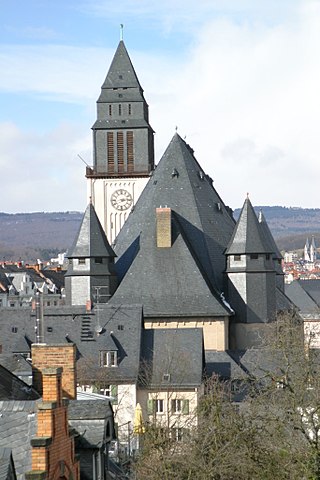
The Lutherkirche is one of four main Protestant churches in Wiesbaden, the capital of Hesse, Germany. It was built between 1908 and 1910 in Jugendstil and in accordance with the Wiesbadener Programm, to a design by Friedrich Pützer. With two organs and good acoustics, it is also a concert venue.

The Rheingau Musik Festival (RMF) is an international summer music festival in Germany, founded in 1987. It is mostly for classical music, but includes other genres. Concerts take place at culturally important locations, such as Eberbach Abbey and Schloss Johannisberg, in the wine-growing Rheingau region between Wiesbaden and Lorch.

The Reger-Chor is a German-Belgian choir. It was founded in Wiesbaden in 1985 and has been conducted by Gabriel Dessauer in Wiesbaden. Since 2001 it has grown to Regerchor-International in a collaboration with the organist Ignace Michiels of the St. Salvator's Cathedral of Bruges. The choir performs an annual concert both in Germany and Belgium of mostly sacred choral music for choir and organ. Concerts have taken place regularly in St. Bonifatius, Wiesbaden, and in the cathedral of Bruges in its series "Kathedraalconcerten". The choir performed additional concerts at other churches of the two countries and in the Concertgebouw of Bruges.
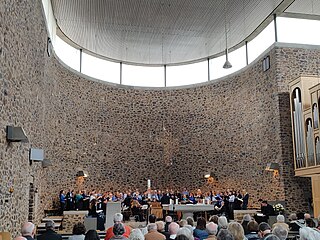
St. Martin is the name of a Catholic parish and church in Idstein, Rheingau-Taunus-Kreis, Germany. The official name of the church is Katholische Pfarrkirche St. Martin. The name of the parish became St. Martin Idsteiner Land on 1 January 2017, when it was merged with five other parishes. The parish is part of the Diocese of Limburg.

Gabriel Dessauer is a German cantor, concert organist, and academic teacher. After studies with Diethard Hellmann and Franz Lehrndorfer, he was responsible for the church music at St. Bonifatius, Wiesbaden from 1981 to 2021, conducting the Chor von St. Bonifatius until 2018. Besides normal church services, he conducted them in regular masses with soloists and orchestra for Christmas and Easter and a yearly concert. In 1995 he prepared the choir for a memorial concert commemorating the 50th anniversary of the end of World War II, performing Britten's War Requiem with choirs from countries involved in the war, and concerts in Wiesbaden and Macon, Georgia. Programs of choral concerts included Hermann Suter's Le Laudi in 1998, the German premiere of Rutter's Mass of the Children in 2004, and the world premiere of Colin Mawby's Bonifatiusmess in 2012 which he had commissioned for the choir's 150th anniversary. The concert of 2008, Vivaldi's Gloria and Haydn's Nelson Mass, was also performed at San Paolo dentro le Mura in Rome.
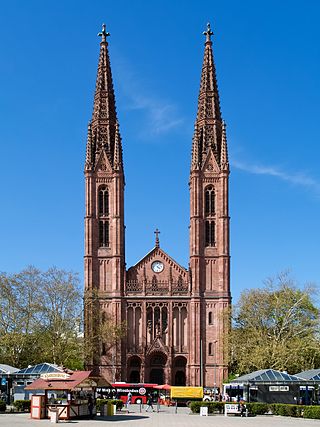
St. Bonifatius in Wiesbaden, Germany, is the central Catholic parish and church in the capital of Hesse. The present building was designed by architect Philipp Hoffmann in Gothic Revival style and built from 1844 to 1849. Its twin steeples of 68 m (223 ft.) dominate the Luisenplatz. The parish is part of the Diocese of Limburg.
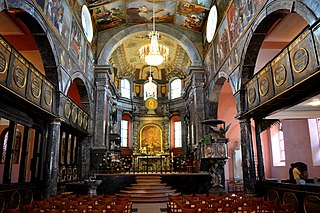
The Unionskirche is the active Protestant parish church of Idstein, a town in the Rheingau-Taunus district in the German state of Hesse. Idstein was a residence of the counts of Nassau. The church building in the center of the historic Altstadt dates back to the 14th century when it was built as a collegiate church. It became Lutheran during the Reformation. Its interior was adapted in the 17th century to become a Lutheran Predigt- und Hofkirche. The most prominent decoration in the church is the series of 38 paintings by the Flemish painter Michael Angelo Immenraedt, an exponent of Flemish Baroque painting, and others. They follow a program of biblical scenes.

Rheingauer Dom is the colloquial name for the Catholic parish church in Geisenheim, Germany. Officially Pfarrkirche Heilig Kreuz, the large church in the Rheingau region is called Dom although it was never a bishop's seat. The present building was begun in the 16th century, but major features such as an expansion of the nave from three to five vaults, the towers, the organ and several altars were added in the 19th century. The parish is part of the Diocese of Limburg.

Marktkirche is the main Protestant church in Wiesbaden, the state capital of Hesse, Germany. The neo-Gothic church on the central Schlossplatz was designed by Carl Boos and built between 1853 and 1862. At the time it was the largest brick building of the Duchy of Nassau. It is also called Nassauer Landesdom.

Rheingauer Kantorei, now Neue Rheingauer Kantorei, is a mixed choir of the Rheingau region in Germany, performing mostly sacred music in services and concerts.
Frank Stähle was a German musician, a choral conductor and the director of Dr. Hoch's Konservatorium in Frankfurt from 1979 to 2007.
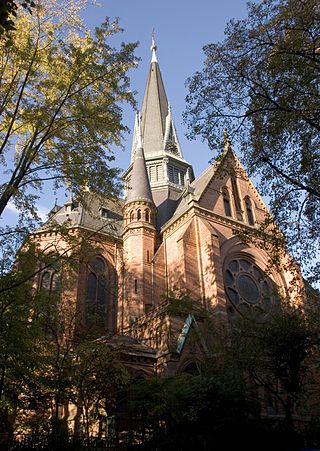
The Bergkirche is one of four main Protestant churches in Wiesbaden, the capital of Hesse, Germany. It was completed in 1879 in Gothic Revival based on a design by Johannes Otzen. The church is focused on having the altar and pulpit close to the congregation, following Luther's concept of a universal priesthood. It also serves as a concert venue for church music.
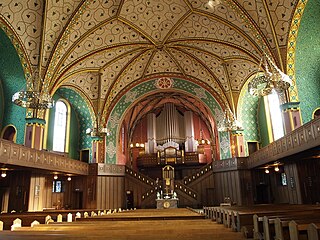
The Wiesbadener Programm is a program for Protestant church architecture developed in Wiesbaden, the capital of Hesse, Germany, in the late 19th century. It contradicted an older Eisenacher Regulativ from 1861 which demanded that new church buildings had to follow Romanesque Revival style or Gothic Revival style.
Emil Veesenmeyer (1857–1944) was a German theologian, minister of the Bergkirche in Wiesbaden, the capital of Hesse, and later a dean.
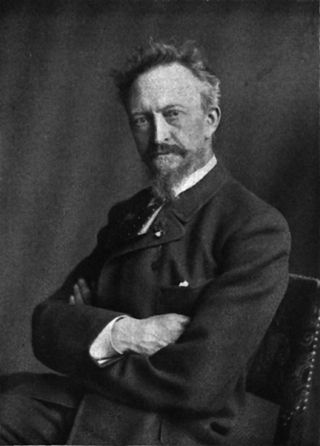
Johannes Otzen was a German architect, urban planner, architectural theorist and university teacher. He worked mainly in Berlin and Northern Germany. Otzen was involved in urban planning in Berlin.

The church St. Laurentii is the parish church of a Lutheran congregation in the centre of Itzehoe, Schleswig-Holstein, Germany. The full name is Stadtkirche St. Laurentii. Completed in 1718, it is the town's largest religious building. It serves as a parish church and as a concert venue.

St. Jakobus is a Catholic church and a former parish in Rüdesheim am Rhein, Hesse, Germany. It dates back to the 10th century, was expanded around 1400, and again in 1913/14. The church was severely damaged by bombing in World War II, and rebuilt from 1947 to 1956. It is a listed historic monument and serves also as a concert venue.

Idsteiner Kantorei is a mixed choir in Idstein, Rheingau-Taunus-Kreis, Germany. The group performs regularly in the Protestant Unionskirche in services and concerts, also in smaller churches of the region and internationally. They practice collaboration with other choirs for larger projects.

St. Martin is a Gothic church and the associated Catholic parish in Lorch am Rhein, Hesse, Germany. In 2002, it became part of the Rhine Gorge, a UNESCO World Heritage Site. The church features the oldest and largest monochrome wood-carved altar in Germany. Its organ from 1984 makes it also a concert venue, where international organists such as Olivier Latry have performed.




















